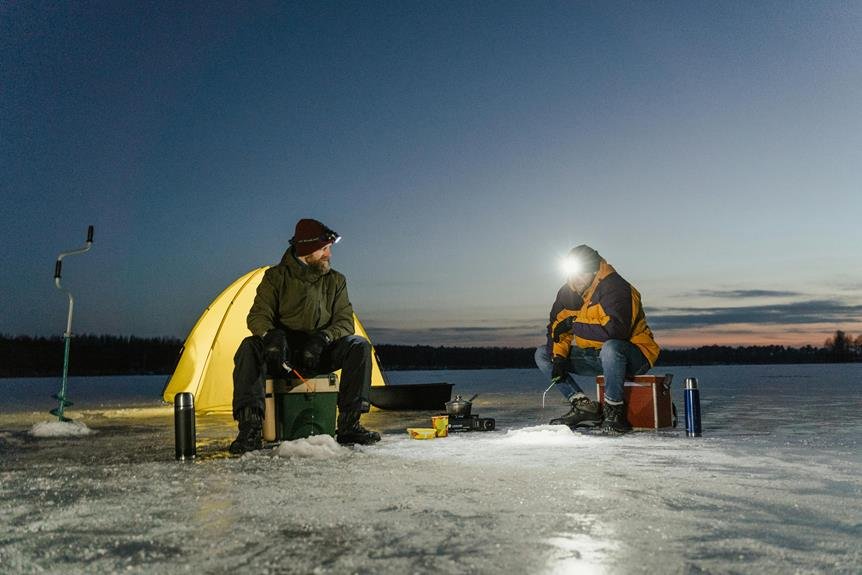
When venturing into the winter wilderness, selecting the appropriate tent can make or break your camping experience. Imagine the wind howling outside, the snow piling up, and the need for a sanctuary that stands firm amidst the cold. Picture yourself inside a cozy shelter, protected from the elements. Now, picture choosing the wrong tent for such conditions. The right tent is your shield against the harsh winter environment, providing safety and comfort. But how do you ensure you've picked the perfect one? Let's explore the key factors together.
Consider the Tent Capacity
Have you determined how many people will be sleeping in the tent during your winter camping trip? It's crucial to consider the tent capacity to ensure a comfortable experience. When selecting a winter camping tent, make sure to account for the number of individuals who'll be sharing the space. If you're camping with a group, opt for a tent that accommodates everyone without feeling cramped. Keep in mind that winter camping requires more gear and insulation, so a slightly larger tent may be beneficial.
Before making a purchase, carefully review the tent's dimensions and capacity specifications. Manufacturers often provide guidelines on how many people can sleep comfortably in the tent. However, it's essential to factor in not just the number of individuals but also the space needed for gear storage and moving around inside the tent. Additionally, consider if you prefer a snug fit or extra room for comfort. By evaluating the tent capacity accurately, you can ensure a cozy and enjoyable winter camping trip for all.
Evaluate the Tent Design
When selecting a winter camping tent, assess the tent design to ensure it meets your specific needs and preferences. Consider the shape of the tent – dome tents are sturdy and handle snow accumulation well, while tunnel tents offer more space but may not be as robust in extreme conditions.
Look at the tent's ventilation system; proper airflow is crucial to prevent condensation inside the tent. Check if the tent has multiple doors for easy access and vestibules for gear storage, especially important during winter when extra equipment needs to be kept dry.
Additionally, evaluate the setup process – some designs are easier to pitch in cold conditions or with gloves on. Pay attention to the tent's stability in wind and snow; features like reinforced guy out points and strong poles are beneficial.
Choose a design that balances weight, space, and weather resistance to ensure a comfortable and safe winter camping experience.
Check the Material and Insulation
Examine the material and insulation of the winter camping tent to ensure it provides adequate protection against the cold weather conditions. Look for tents made from durable materials such as ripstop nylon or polyester, as these fabrics are sturdy and can withstand harsh winter conditions.
Insulation is crucial for retaining heat inside the tent, so check for features like double-layered walls, insulated floors, and a rainfly that extends close to the ground to trap warmth. Additionally, consider tents with aluminum poles, as they're more durable and less likely to snap in freezing temperatures compared to fiberglass poles.
Insulation can also come from features like reflective coatings on the tent fabric or added thermal layers within the walls. Remember that a well-insulated tent won't only keep you warm but also prevent condensation buildup inside, which can make your camping experience uncomfortable.
Review Additional Features
To ensure your winter camping tent meets all your needs, consider reviewing additional features that can enhance your camping experience.
Look for tents with a snow skirt or snow flaps at the bottom of the tent. These features prevent snow from blowing inside and provide extra insulation.
Additionally, tents with multiple ventilation options are beneficial. Proper ventilation helps reduce condensation inside the tent, keeping you and your gear dry.
Some tents come with vestibules, which offer extra storage space for gear and muddy boots, keeping the interior tidy.
Another useful feature to consider is a footprint or groundsheet. This extra layer under your tent provides added protection against moisture and sharp objects on the ground.
Reflective guy lines can be handy in low light conditions, preventing accidental tripping.
Lastly, tents with interior pockets help you organize small items like headlamps, phones, or maps easily.
Reviewing these additional features can make your winter camping trip more comfortable and enjoyable.




